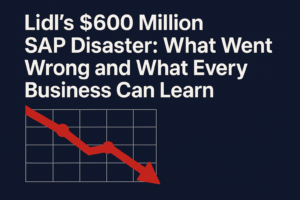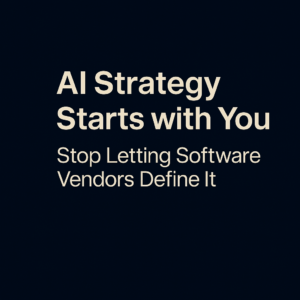In a recent video, we had a commenter suggest that legacy systems are the root cause of resistance to change, hinting at the idea of discarding them entirely and starting afresh with implementations. While this suggestion may seem exaggerated or even facetious, it prompts a critical question: Should companies truly consider abandoning their legacy systems in favor of new ones?
Table of Contents
ToggleUnderstanding Legacy Systems
Legacy systems, often deeply ingrained within organizational infrastructure, present a complex dilemma. On one hand, they may be outdated, cumbersome, and resistant to modernization efforts. On the other hand, they are often interconnected with various aspects of operations, from software dependencies to regulatory compliance measures. Therefore, the decision to discard them cannot be taken lightly.
The Myth of Greenfield Implementations
The allure of Greenfield implementations lies in the promise of a fresh start, free from the constraints of legacy systems. However, this notion overlooks the valuable investments and knowledge embedded within existing infrastructure. Transitioning to Greenfield projects requires significant time, resources, and expertise, with uncertainties and complexities that can lead to delays and cost overruns. Moreover, the transition process itself, including data migration and user adoption, can disrupt operations and may not always deliver the anticipated benefits. Therefore, while Greenfield implementations offer potential advantages, organizations must carefully weigh the risks and consider alternative approaches that leverage the strengths of their current systems. A pragmatic and strategic approach to digital transformation ensures effective modernization while minimizing disruption and maximizing long-term success.
Strategic Considerations in Digital Transformation
Implementing new systems involves more than just technological upgrades. It requires careful consideration of existing dependencies, interoperability requirements, and long-term sustainability. For instance, in industries like manufacturing or healthcare, where intricate workflows and regulatory compliance are paramount, simply discarding legacy systems is not a feasible option.
Balancing Continuity with Innovation
Balancing continuity with innovation is paramount for organizations navigating the complexities of digital transformation. While there is often a temptation to discard legacy systems in favor of new, cutting-edge technologies, a strategic approach recognizes the value embedded within existing infrastructure. By acknowledging the strengths and capabilities of legacy systems, organizations can leverage them as a foundation for modernization efforts. This involves a careful assessment of current processes and technologies to identify areas where improvements can be made, while also considering how to preserve and integrate existing systems where they continue to provide value.
In practice, this approach entails a blend of retaining what works, selectively upgrading components, and integrating new technologies where necessary. Rather than pursuing a wholesale replacement of legacy systems, organizations can prioritize incremental improvements and targeted enhancements. This allows for a more gradual transition, minimizing disruption to operations while maximizing the return on investment. Additionally, by adopting a modular approach to modernization, organizations can adapt and evolve their systems over time, incorporating emerging technologies and addressing evolving business needs. In essence, balancing continuity with innovation requires a nuanced understanding of the organization’s unique requirements and a willingness to embrace change while preserving the foundations that have served it well.
The Cost Implications
Moreover, the cost implications of abandoning legacy systems cannot be overlooked. Companies have invested significant resources in these systems over the years, from licensing fees to maintenance contracts. Abruptly discarding them would not only entail financial losses but also disrupt ongoing operations.
Navigating Risks and Challenges
Navigating the transition to new systems is fraught with risks, including data loss, workflow disruptions, and employee resistance. Meticulous planning and robust data migration strategies are essential to safeguard against data loss and ensure the integrity of critical information. Additionally, the introduction of new systems can disrupt established workflows, causing productivity bottlenecks. Overcoming employee resistance requires effective change management strategies that prioritize communication and training.
Furthermore, the interconnected nature of business operations magnifies the risks associated with transition. Even minor hiccups can have ripple effects throughout the organization, impacting customer service and financial performance. Effective risk management requires ongoing monitoring, contingency planning, and rapid response capabilities. By anticipating potential pitfalls and implementing proactive risk mitigation strategies, organizations can minimize the impact of transition-related challenges and ensure a smooth transformation. Ultimately, successful navigation of these risks and challenges is essential for realizing the full potential of digital transformation initiatives.
A Pragmatic Approach
In essence, the decision to retain or replace legacy systems depends on a multitude of factors, including the organization’s industry, operational requirements, and long-term objectives. While the allure of Greenfield implementations may be tempting, the pragmatic approach lies in leveraging the strengths of existing systems while embracing innovation where it adds value.
Conclusion
The lighthearted remark serves as a reminder of the complex nature of technological change within organizations. While the idea of discarding legacy systems may elicit a chuckle, the reality demands a more nuanced and strategic approach. By carefully balancing continuity with innovation, organizations can navigate the digital landscape effectively and position themselves for future success.

How can we help?
At Third Stage Consulting, we’re committed to helping organizations navigate the complexities of digital transformation, including data management. Whether you’re embarking on a new transformation journey or seeking to optimize existing processes, our team is here to support you every step of the way.




